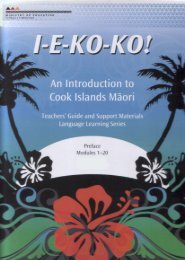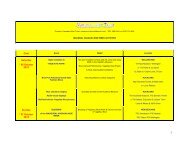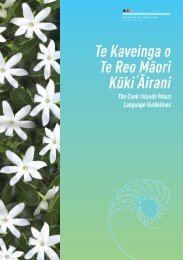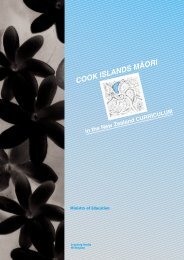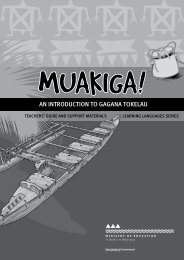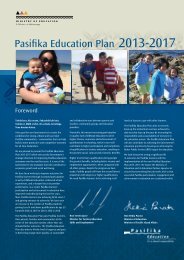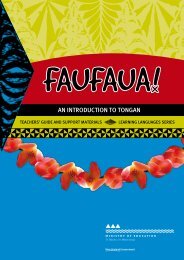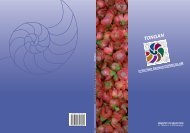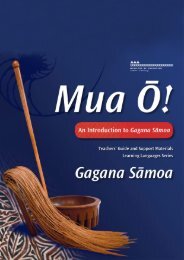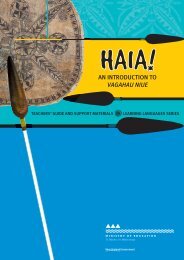Ta'iala mo le Gagana SÄmoa - Pasifika Education Community
Ta'iala mo le Gagana SÄmoa - Pasifika Education Community
Ta'iala mo le Gagana SÄmoa - Pasifika Education Community
You also want an ePaper? Increase the reach of your titles
YUMPU automatically turns print PDFs into web optimized ePapers that Google loves.
‘O <strong>le</strong> fuafuaina o se polokalame <strong>mo</strong> <strong>le</strong> gagana ma <strong>le</strong>aganu‘u fa‘asā<strong>mo</strong>aSetting up a gagana ma <strong>le</strong> aganu‘u fa‘asā<strong>mo</strong>a programmeIt is useful to begin planning a programme by identifying each child’s current <strong>le</strong>vel of gagana Sā<strong>mo</strong>aand whether they are first language speakers or not. The language their parents use in the home willbe a factor to take into account when considering the child’s individual needs. Teachers can observechildren, as part of their daily practice, to get an idea of the children’s <strong>le</strong>vel of familiarity with gaganaSā<strong>mo</strong>a and whether they use it as their first language.This data will enab<strong>le</strong> teachers to se<strong>le</strong>ct goals and plan programmes that make connections to thelanguage the children have already <strong>le</strong>arned and the language they need to <strong>le</strong>arn. Where childrenalready de<strong>mo</strong>nstrate a <strong>le</strong>vel of proficiency in the language, teachers need to consider ways to enrichtheir language and cultural development by providing new experiences and discussing them ingagana Sā<strong>mo</strong>a.Setting up a gagana ma <strong>le</strong> aganu‘u fa‘asā<strong>mo</strong>a programme in an early childhood setting involvescollaboration with the local community and their ongoing support. Teachers need to think aboutthe kinds of support that the local Sa<strong>mo</strong>an community can offer, and they need to talk about thiswith families when discussing their children’s needs and achievements. Making contact withSa<strong>mo</strong>an community organisations, where appropriate, is also helpful.40Teachers may find it useful to plan units of work using the cyc<strong>le</strong> illustrated on page 39. They canthen observe and record the language <strong>le</strong>arning that takes place and use this information to informfurther planning.Material resources support the teaching and <strong>le</strong>arning of gagana Sā<strong>mo</strong>a. Developing Programmesfor Teaching Pacific Islands Languages and the accompanying Guidelines for Sa<strong>mo</strong>an LanguageProgrammes contain ideas about programme planning and descriptions of gagana Sā<strong>mo</strong>a books andother resources availab<strong>le</strong>. Teachers can also consult www.minedu.govt.nz (for current information forearly childhood education in general) and www.tki.org.nz (for information and resources specific to<strong>Pasifika</strong> languages, including gagana Sā<strong>mo</strong>a).Iloilo o <strong>le</strong> alualu ‘i lumaAssessing progressWhen preparing to imp<strong>le</strong>ment a programme, it is crucial to find out the child’s current <strong>le</strong>vel ofgagana Sā<strong>mo</strong>a in listening and speaking. The planning cyc<strong>le</strong> on page 39 includes an emphasis onparents’ contributions. The concept of soālaupu<strong>le</strong> (see page 21) encompasses a col<strong>le</strong>ctive approachto assessment that includes everyone’s know<strong>le</strong>dge about the child.For specific guidance on appropriate assessment approaches at early childhood <strong>le</strong>vel, refer toTe Whāriki and Kei Tua o te Pae/Assessment for Learning: Early Childhood Exemplars. The earlychildhood exemplars illustrate a wide range of suggestions for assessing children’s progress andidentifying their next <strong>le</strong>arning steps. Although these suggestions can be adapted to the context ofteaching and assessing gagana Sā<strong>mo</strong>a, the practice of soālaupu<strong>le</strong> also needs to be explored to ensurethe full participation of a Sa<strong>mo</strong>an child’s community (including, for examp<strong>le</strong>, their family and church)in the assessment.The different purposes for carrying out assessment in early childhood settings, together with somesuggested techniques, are set out on the facing page.



